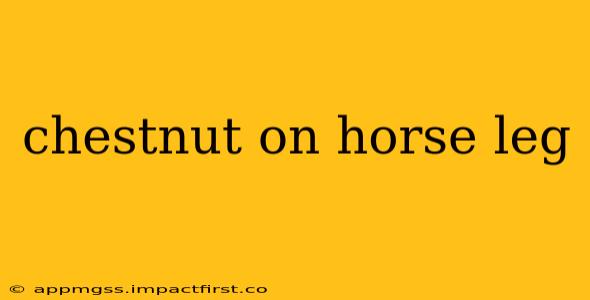Chestnut markings on a horse's leg, also known as ergot and fetlock, are common and often overlooked features, yet they hold significance in equine identification and breed characteristics. Understanding these markings can provide valuable insights into a horse's lineage, and even offer clues to its overall health. This article will delve into the specifics of chestnuts on horse legs, addressing common questions and clarifying any misconceptions.
What are Chestnuts on a Horse's Leg?
Chestnuts are hard, horny growths found on the inside of a horse's legs. They're not actually chestnuts in the culinary sense, but rather remnants of what were once fully developed toes on the horse's ancestors. These growths are usually dark brown or black in color and vary in size and shape depending on the horse's breed and individual characteristics.
There are typically two chestnuts on each leg: one above the knee or hock (called the ergot), and one just below the fetlock joint (called the fetlock). Some horses may have additional, smaller chestnuts higher up on their legs.
What is the Difference Between an Ergot and a Fetlock?
The terms "ergot" and "fetlock" often cause confusion, as both refer to chestnut-like growths on the horse's legs. However, they are located in distinct areas:
- Ergot: This is the chestnut found above the fetlock joint, closer to the knee or hock.
- Fetlock: This is the chestnut located below the fetlock joint, on the inside of the leg.
Are Chestnuts Important for Identifying a Horse?
While not as uniquely identifying as a brand or a distinctive coat pattern, chestnuts can be helpful in identifying a horse, particularly when used in conjunction with other markings. Their size, shape, and number can be recorded in a horse's description and help to distinguish it from other horses, especially within a large herd or stable. This information is often included in a horse's registration papers.
Do Chestnuts Serve Any Purpose?
The evolutionary purpose of chestnuts remains unclear, however many speculate they're vestigial remains with no significant function in the modern horse.
Can Chestnuts Be Removed?
While chestnuts can be removed, it's generally not recommended. The procedure is often painful for the horse and carries the risk of infection. Furthermore, removing chestnuts removes a potentially useful identifying feature.
What if a Chestnut is Damaged or Missing?
A damaged or missing chestnut might be due to injury or rubbing. In such cases, proper veterinary care is crucial to address the underlying issue and prevent infection. A missing chestnut should be noted in any horse identification records.
Can the Size or Shape of Chestnuts Indicate Anything About the Horse's Health?
While the size and shape of chestnuts are generally consistent throughout a horse's life, significant changes could indicate an underlying health concern. Any unusual changes in the appearance of a chestnut should be brought to the attention of a veterinarian.
Conclusion
Chestnuts are a fascinating and often-overlooked aspect of equine anatomy. Although their function is unclear, their presence provides useful information for horse identification and can offer clues to potential health issues. Understanding their characteristics contributes to a more comprehensive appreciation of these magnificent animals.
